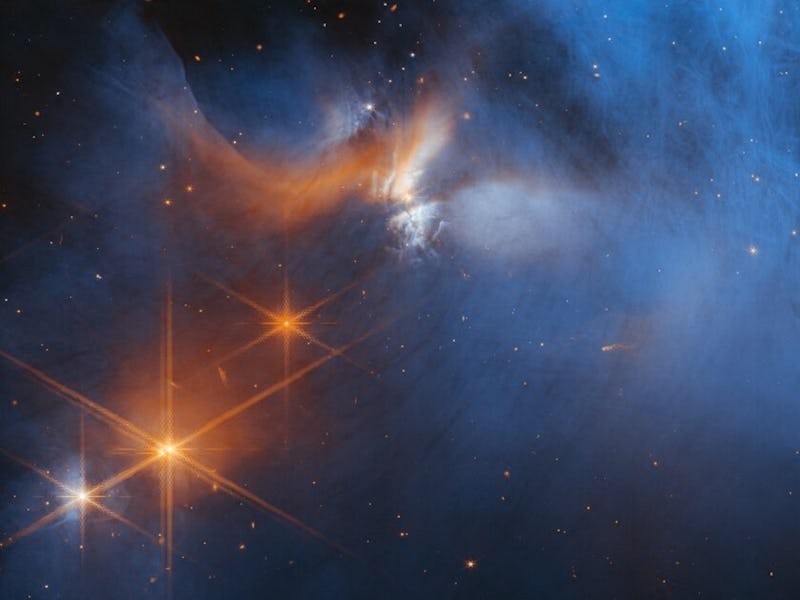Look! Webb Telescope finds icy ingredients for organic chemicals in deep space
The coldest, most distant ices ever measured could have big implications for planets -- and life.

Astronomers found some key ingredients for life, and for livable worlds, in a dark, dense cloud of gas about 550 light years away.
The chemicals that astronomers recently found, clinging to tiny dust grains in a cold cloud of molecular gas, aren’t the building blocks of life—– but they’re the building blocks for the building blocks. And those precursors, as chemists call them, could be a pretty common part of the starter pack for newly formed planets and solar systems, according to a recent study published in the journal Nature Astronomy.
What’s New — Using the James Webb Space Telescope’s (JWST) Near Infrared Spectrometer (NIRSpec), Leiden University astronomer Melissa McClure spotted the telltale chemical fingerprints of water ice, along with frozen carbon dioxide, ammonia, methane, and even methanol in a dense gas cloud called Chameleon I.
New stars are forming in the orange region of the molecular cloud Chameleon I, on the left side of this JWST NIRCam image (it’s called a molecular cloud because it’s made mostly of molecular hydrogen: pairs of hydrogen items bonded together). The blue area on the right is a cold, dense region of gas where stars haven’t formed yet, and it’s already seeded with several types of ice. The fainter orange stars are in the distant background.
New stars are beginning to coalesce and flare to life in the cloud, but the region McClure and her colleagues studied with JWST is the coldest part of the cloud, far from the bustle and warmth of the stellar nursery. Eventually, however, that will change. And someday, when planets form around those future stars, their starter package will include some surprisingly complex organic molecules — the kinds of things the building blocks of life are made of. Molecules like the ones that make up the newly-detected ices are the basic building blocks for things like sugars and amino acids.
“This could mean that the presence of precursors to prebiotic molecules in planetary systems is a common result of star formation, rather than a unique feature of our own Solar system,” says Leiden Observatory astronomer Will Rocha, a co-author of the recent study, in a statement to the press.
And this isn’t the first time astronomers have found ingredients for biochemistry in interstellar space.
Digging Into The Details — One day, the ices floating in the darkness of Chameleon I will stock exoplanet atmospheres with things like water, carbon dioxide, and organic molecules. But for now, what McClure and her colleagues saw are just a few tiny crystals here and there, clinging to tiny grains of interstellar dust — and absorbing starlight that passes through the cloud from distant stars.
Each type of ice absorbs different wavelengths of light, so by looking for telltale dips in the brightness of light from stars on the far side of the cloud — NIR38 and J110621 — at those wavelengths, McClure and her colleagues could find the chemical fingerprint of several types of ice.
This graph shows light being absorbed by ice particles in several wavelengths, as detected by JWST’s NIRSpec instrument.
“In regions that are this cold and dense, much of the light from the background star is blocked, and Webb’s exquisite sensitivity was necessary to detect the starlight and therefore identify the ices in the molecular cloud,” says Klaus Pontoppidan, JWST project scientist and a co-author of the recent study, in a press statement.
What’s Next – McClure and her colleagues’ search for ice in Chameleon I is part of a program they call the Ice Age Project, in which the astronomers hope to trace what happens to ice from the “dark chemistry” of cold molecular clouds to the lives of comets on the outskirts of newly-formed solar systems. JWST will help them gather most of that data.
“This will tell us which mixture of ices – and therefore which elements – can eventually be delivered to the surfaces of terrestrial exoplanets or incorporated into the atmospheres of gas giants or ice planets,” says McClure in a press statement.
Other groups of astronomers are also searching for ice — especially water — in interstellar “reservoirs.”
This article was originally published on